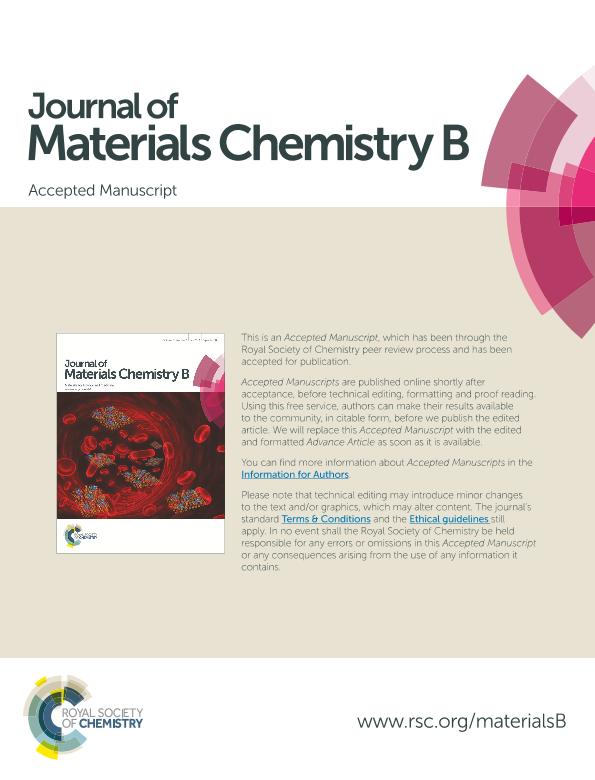Artículo
Didanosine-loaded poly(epsilon-caprolactone) microparticles by a coaxial electrohydrodynamic atomization (CEHDA) technique
Seremeta, Katia Pamela ; Höcht, Christian; Taira, Carlos Alberto
; Höcht, Christian; Taira, Carlos Alberto ; Cortez Tornello, Pablo Roberto
; Cortez Tornello, Pablo Roberto ; Abraham, Gustavo Abel
; Abraham, Gustavo Abel ; Sosnik, Alejandro Dario
; Sosnik, Alejandro Dario
 ; Höcht, Christian; Taira, Carlos Alberto
; Höcht, Christian; Taira, Carlos Alberto ; Cortez Tornello, Pablo Roberto
; Cortez Tornello, Pablo Roberto ; Abraham, Gustavo Abel
; Abraham, Gustavo Abel ; Sosnik, Alejandro Dario
; Sosnik, Alejandro Dario
Fecha de publicación:
08/2015
Editorial:
Royal Society of Chemistry
Revista:
Journal Of Materials Chemistry B
ISSN:
2050-7518
Idioma:
Inglés
Tipo de recurso:
Artículo publicado
Clasificación temática:
Resumen
The goal of this study was to investigate the electrohydrodynamic atomization (EHDA) technology to encapsulate the water-soluble antiretroviral didanosine (ddI) within poly(epsilon-caprolactone) (PCL) particles and stabilize it in the gastric medium where it undergoes fast degradation. A preliminary study employing a one-needle setup enabled the adjustment of the critical process parameters. Then, a configuration of two concentric needles named coaxial electrohydrodynamic atomization (CEHDA) led to the formation of ddI-loaded PCL microcapsules. Scanning electron microscopy analysis showed that the microparticles were spherical and with narrow size distribution. Attenuated total reflectance/Fourier transform infrared spectroscopy confirmed that most of the drug was efficiently encapsulated within the particles, whereas differential scanning calorimetry and X-ray powder diffraction revealed that the drug was preserved mainly in crystalline form. The loading capacity was relatively high (approximately 12% w/w), and the encapsulation efficiency was approximately 100%. In vitro release assays (PBS pH ¼ 7.4) indicated that ddI was released almost completely within 2 h. Moreover, the delayed release was expected to isolate ddI from the biological fluids during the gastric transit. Finally, pharmacokinetics studies in rats showed that ddI-loaded particles lead to a statistically significant increase of the oral bioavailability of almost 4 times and a 2-fold prolongation of the half-life with respect to a ddI aqueous solution, supporting the use of CEHDA as a promising reproducible, scalable and cost-viable technology to encapsulate water-soluble drugs within polymeric particles.
Archivos asociados
Licencia
Identificadores
Colecciones
Articulos(INTEMA)
Articulos de INST.DE INV.EN CIENCIA Y TECNOL.MATERIALES (I)
Articulos de INST.DE INV.EN CIENCIA Y TECNOL.MATERIALES (I)
Articulos(NANOBIOTEC)
Articulos de INSTITUTO DE NANOBIOTECNOLOGIA
Articulos de INSTITUTO DE NANOBIOTECNOLOGIA
Citación
Seremeta, Katia Pamela; Höcht, Christian; Taira, Carlos Alberto; Cortez Tornello, Pablo Roberto; Abraham, Gustavo Abel; et al.; Didanosine-loaded poly(epsilon-caprolactone) microparticles by a coaxial electrohydrodynamic atomization (CEHDA) technique; Royal Society of Chemistry; Journal Of Materials Chemistry B; 3; 1; 8-2015; 102-111
Compartir
Altmétricas



